Madonna benoit interesting facts about the painting. Leonardo da Vinci. "Madonna Benois" - the art story
St. Petersburg
(Inv. 2773)
"Madonna Benois" or "Madonna with a flower"(-) - an early painting by Leonardo da Vinci, presumably left unfinished. In 1914, it was acquired by the Imperial Hermitage from Maria Alexandrovna, the wife of the court architect Leonty Nikolaevich Benois.
Description
"Madonna with a Flower" is one of the first works of the young Leonardo. The Uffizi Gallery in Florence has a drawing with the following entry:
It is believed that one of them is the Benois Madonna, and the second is the Madonna with a Carnation from Munich.
It is likely that both paintings were the first works of Leonardo as an independent painter. At that time he was only 26 years old and already six years old, since he left the workshop of his teacher Andrea Verrocchio. He already had his own style, but of course he to a large extent based on the experience of the Florentines of the XV century. There is also no doubt that Leonardo knew about the painting “Madonna and Child”, performed by his teacher in -1470. As a consequence, for both pictures common features are both a three-quarter turn of the bodies, and the similarity of images: the youth of both Madonnas and the large heads of the Infants.
Da Vinci places the Madonna and Child in a semi-dark room, where the only source of light is a double window located at the back. Its greenish light cannot dispel the twilight, but at the same time is sufficient to highlight the figure of the Madonna and the young Christ. The main "work" is done by the light pouring from the top left. Thanks to him, the master manages to revive the picture with the play of chiaroscuro and sculpt the volume of two figures.
"One of the first independent work the young painter is distinguished by the novelty of the interpretation of the plot, solved as a life scene, where a young mother, dressed in the costume of Leonardo's contemporaries and combed in the fashion of those years, playing with her son, hands him a cruciferous flower. The traditional symbol of the crucifixion is perceived as an innocent toy, to which the baby Jesus reaches awkwardly in a childish way, evoking the smile of a young Madonna admiring her son's first attempts to master the world.
In his work on the Benois Madonna, Leonardo used an oil painting technique that almost no one in Florence had known before. And although the colors have inevitably changed over the five centuries, becoming less bright, it is still clearly noticeable that the young Leonardo abandoned the variegation of colors traditional for Florence. Instead, he makes extensive use of the possibilities of oil paints in order to more accurately convey the texture of materials and the nuances of light and shade. The bluish-green gamma replaced the red light from the picture, in which the Madonna was usually dressed. At the same time, an ocher color was chosen for the sleeves and cloak, harmonizing the ratio of cold and warm shades.
"Madonna" by Leonardo was widely known to the artists of that time. And not only Italian masters used the techniques of the young da Vinci in their works, but also painters from the Netherlands. It is believed that at least a dozen works were made under his influence. Among them is Lorenzo di Credi's "Madonna and Child with John the Baptist" from the Dresden Art Gallery, as well as "Madonna with Carnations" by Raphael. However, then her traces were lost, and for centuries the picture of Leonardo was considered lost.
| "Madonna with a Carnation" by Leonardo da Vinci. 1478. Alte Pinakothek, Munich | Madonna and Child by Andrea Verrocchio. 1466-1470. Berlin Art Gallery. | "Madonna and Child with John the Baptist" by Lorenzo di Credi. Dresden Art Gallery | "Madonna of the Carnations" by Raphael, circa 1506-7. National Gallery, London |
History of the painting
Until now, there is no exact information about the early fate of the picture. It is believed that M. F. Bocchi spoke about her in his book “Sights of the City of Florence”, published in 1591:
The painting, traces of which were lost until the 19th century, got its name from the last owners - the Russian artistic dynasty Benois. In 1914, it was acquired by the Imperial Hermitage from the wife of the court architect Leonty Nikolaevich Benois - Maria Alexandrovna (1858-1938), nee Sapozhnikova. The painting was inherited from her father, a millionaire merchant and philanthropist A. A. Sapozhnikov (son of the owner art gallery A. P. Sapozhnikov). There was a legend in the family that the painting was bought from wandering Italian musicians in Astrakhan, where the Sapozhnikovs had a large fishery. There was no other information about the fate of the painting at the beginning of the 20th century.
A few years later he corrected himself:
This version was widely replicated by other authors. Often, without any reference to sources, they added that the work was once in the collection of Counts Konovnitsyn.
It is assumed that the master who carried out the translation was a former employee of the Imperial Hermitage and a graduate of the Academy of Arts Evgraf Korotky. It is not clear whether at that time the painting was still in the collection of General Korsakov or had already been bought by Sapozhnikov.
| One unfortunate day I was invited to witness the Benois Madonna. Staring at me was a young woman with a bald forehead and swollen cheeks, a toothless grin, myopic eyes and a wrinkled neck! An eerie ghost of an old woman plays with a child: his face resembles an empty mask, and swollen bodies and limbs are attached to it. Pathetic hands, stupidly vain folds of skin, the color is like serum. And yet I had to admit that this terrible creature belongs to Leonardo da Vinci ... |
The public wanted the painting to remain in Russia. M. A. Benois wanted the same, and therefore gave up the "Madonna" for 150 thousand rubles to the Hermitage. The amount was paid in installments, and the last payments were made after the October Revolution.
Notes
Literature
- "New time". 1913. November 5, 11, 27.
- Wrangel N. N. Benois Madonna by Leonardo da Vinci. SPb., 1914.
- Bannikov A.P. Astrakhan collection of A.P. Sapozhnikov // Panorama of the Arts. M., 1988. Issue. eleven.
- Maho O. G. Leonardo da Vinci. "Madonna with a flower". - St. Petersburg. : State Hermitage, 2007. - 20 p. - ISBN 5-93572-246-1.
"Madonna Benois" or "Madonna with a flower"(-) - painting by the great Italian artist Leonardo da Vinci. In 1914, it was acquired by the Imperial Hermitage from Maria Alexandrovna, the wife of the court architect Leonty Nikolaevich Benois.
A few years later he corrected himself:
This version was widely replicated by other authors. Often, without any reference to sources, they added that the work was once in the collection of the Counts Konovnitsyn.
Description

"Madonna with a Flower" is one of the first works of the young Leonardo. The Uffizi Gallery in Florence has a drawing with the following entry:
It is believed that one of them is the Benois Madonna, and the second is the Madonna with a Carnation from Munich.
It is likely that both paintings were the first works of Leonardo as an independent painter. At that time he was only 26 years old and already six years old, since he left the workshop of his teacher Andrea Verrocchio. He already had his own style, but, of course, he relied heavily on the experience of the Florentines of the 15th century. There is also no doubt that Leonardo knew about the painting “Madonna and Child”, performed by his teacher in -1470. As a result, for both paintings, both the three-quarter turn of the bodies and the similarity of images are common features: the youth of both Madonnas and the large heads of the Babies.
Da Vinci places the Madonna and Child in a semi-dark room, where the only source of light is a double window located at the back. Its greenish light cannot dispel the twilight, but at the same time is sufficient to highlight the figure of the Madonna and the young Christ. The main "work" is done by the light pouring from the top left. Thanks to him, the master manages to revive the picture with the play of chiaroscuro and sculpt the volume of two figures.
In his work on the Benois Madonna, Leonardo used an oil painting technique that almost no one in Florence had known before. And although the colors have inevitably changed over the five centuries, becoming less bright, it is still clearly noticeable that the young Leonardo abandoned the variegation of colors traditional for Florence. Instead, he makes extensive use of the possibilities of oil paints in order to more accurately convey the texture of materials and the nuances of light and shade. The bluish-green gamma replaced the red light from the picture, in which the Madonna was usually dressed. At the same time, an ocher color was chosen for the sleeves and cloak, harmonizing the ratio of cold and warm shades.
In the 19th century, the “Madonna with a Flower” was successfully transferred from the board to the canvas, which is mentioned in the “Register of the Paintings of Mr. Alexander Petrovich Sapozhnikov, compiled in 1827”:
It is assumed that the master who carried out the translation was a former employee of the Imperial Hermitage and a graduate of the Academy of Arts Evgraf Korotky. It is not clear whether at that time the painting was still in the collection of General Korsakov or had already been bought by Sapozhnikov.
Notes
Literature
O. G. Makho Leonardo da Vinci. "Madonna with a flower". - St. Petersburg: State Hermitage, 2007. - 20 p. - ISBN 5-93572-246-1
Details Category: Fine arts and architecture of the Renaissance (Renaissance) Posted on 31.10.2016 14:13 Views: 897Leonardo da Vinci is one of the largest representatives of the art of the High Renaissance, an example of a "universal man".
He was an artist, sculptor, architect, scientist (anatomist, naturalist), inventor, writer, musician.
His full name is Leonardo di ser Piero da Vinci, translated from Italian it means "Leonardo, son of Monsieur Piero of Vinci".
In the modern sense, Leonardo did not have a surname - "da Vinci" simply means "(born) from the town of Vinci."
Leonardo is primarily known to our contemporaries as an artist. Known 19 picturesque paintings brushes by Leonardo.

Supposed self-portrait by Leonardo da Vinci
Art critics cannot say with certainty that famous portrait the old man is a self-portrait. Perhaps this is just a study of the head of the apostle for the Last Supper.
Of the vast artistic and scientific heritage of Leonardo da Vinci (1452-1519), in this article we will consider only the picturesque images of the Madonnas.
"Madonna with a Carnation" (1478)
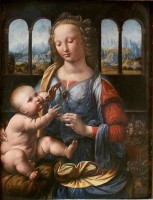
Wood, oil. 42x67 cm. Alte Pinakothek (Munich)
It is believed that this painting was painted by the young Leonardo da Vinci when he was his student in the workshop of the Italian sculptor and painter Verrocchio, one of Leonardo's teachers.
Description of the picture
Madonna is depicted with a barely noticeable semblance of a smile on her lips. There is no other feeling on her face.
Her attire matches the bizarre mountain range in the background. The Madonna is depicted by reception sfumato. This technique was developed by Leonardo da Vinci. It consists in the fact that the outlines of figures and objects are softened by the air enveloping them (sfumato (Italian sfumato - shaded, literally: “disappearing like smoke”).
The baby Jesus, on the contrary, is depicted in vigorous movement. With his still clumsy hands, he tries to grab the red carnation, which his Mother holds in her graceful hand. With the right foot the Baby rests on the pillow, and the left is raised in tension. He so wants to reach the flower!
There is an opinion that this is just a copy from the original, which is still not known.
"Madonna Benois" (or "Madonna with a flower"), 1478-1480

Canvas (translated from wood), oil. 48x31.5 cm State Hermitage Museum (St. Petersburg)
This painting also belongs to the early works of Leonardo. It is considered unfinished. The title of the painting is not the author's. In 1914, the Hermitage acquired it from Maria Alexandrovna Benois, the wife of the court architect Leonty Nikolaevich Benois,
Russian architect and teacher. The picture of Leonardo da Vinci was presented to him by his father-in-law, a wealthy Astrakhan fish merchant.
Description of the picture
The Madonna and Child are depicted in a semi-dark room. The only source of light in it is a double window located at the back. It is the light from this window that highlights the figures in the picture and enlivens it with a play of chiaroscuro.
The artist depicts the Madonna as an ordinary young woman, a mother, lovingly looking at her child, who makes the first attempts to master the world, examining a flower. The Madonna is dressed in a costume worn by contemporaries of Leonardo. And she was combed in the fashion of those years.
The flower indicates the symbolism of the picture cruciferous. This is the symbol of the crucifixion. But for the child at the moment it is just an innocent toy.
"Madonna with a Flower" by Leonardo da Vinci at one time was widely known to the artists of that time. Under her influence, other works by famous artists, including Raphael, were made.
But then, for centuries, Leonardo's painting was considered lost.
"Madonna Litta" (1490-1491)

Canvas, tempera. 42x33 cm State Hermitage Museum (St. Petersburg)
Litta- Milanese aristocratic surname of the XVII-XIX centuries. The painting was in a private collection of this family for several centuries - hence its name. The original title of the painting is Madonna and Child. The Madonna was acquired by the Hermitage in 1864.
It is believed that the painting was painted in Milan, where the artist moved in 1482.
Her appearance marked a new stage in Renaissance art - the establishment of the High Renaissance style.
A preparatory drawing for the Hermitage canvas is kept in Paris at the Louvre.
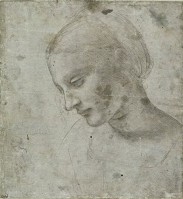
Drawing in the Louvre
Description of the picture
A beautiful young woman breastfeeding her baby represents maternal love as the greatest human value.
The composition of the picture is simple and harmonious. The figures of Mary and the baby Christ are underlined by light chiaroscuro. The harmony in the relationship between the characters in the picture is emphasized by the mountain landscape in symmetrical windows, evoking a sense of the grandeur of the universe.
Madonna's face is shown in profile with a barely perceptible smile at the corners of her mouth. The baby is focused on his occupation, looking absently at the audience. With his right hand he holds his mother's breast, and in his left he holds a goldfinch.
"Madonna in the Rocks"
Leonardo da Vinci created two paintings that are similar in composition. One was written earlier, currently exhibited in the Louvre (Paris). Another (written before 1508) is on display at the London National Gallery.
"Madonna in the Rocks" (1483-1486)
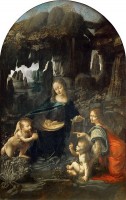
Tree, translated to canvas, oil. 199x122 cm Louvre (Paris)
This version was created for the chapel in the church of San Francesco Grande in Milan. In the XVIII century. it was bought by the English artist Gavin Hamilton and brought to England. Then she was in various private collections, until in 1880 she was bought by the National Gallery.
In 2005, another painting was discovered under this painting using infrared research, so some researchers believe that Leonardo originally planned to write the worship of the baby Jesus.
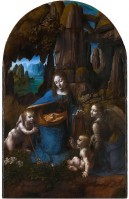
"Madonna in the Rocks". London National Gallery
Description of the paintings
Both canvases depict the Virgin Mary kneeling, holding her hand on the head of little John the Baptist. On the right is the baby Jesus being held by an angel. Jesus raised his hand in blessing. The scene of the relationship of the depicted characters and the landscape background contrast: on the one hand, peace and tenderness, on the other, the disturbing feeling of the harsh landscape. The artist uses his favorite technique (sfumato) to soften the outlines of faces and objects.
"Madonna with a spindle" (circa 1501)
The original of this painting has been lost. But there are three copies, two of which were created in 1501 by Leonardo da Vinci (or students of his school). Another copy was made in 1510.

National Gallery of Scotland
One copy is currently in the National Gallery of Scotland in Edinburgh, the other is in a private collection in New York.
Leonardo's contemporaries liked this small painting of a very young Madonna and Child. Therefore, copies were made.
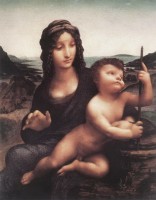
"Madonna with a spindle" (1501)
Wood, oil. 48.3 x 36.9 cm. Private collection
But it is quite possible that this is not a copy, but a new version created in the same 1501 as the original.
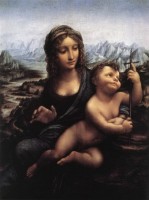
"Madonna with a spindle" (1510)
Oil, canvas on wood, 50.2x36.4 cm. Private collection (New York)
The high quality of the painting proves that it was executed in the workshop of Leonardo da Vinci, possibly under his supervision.
Description of the picture
The painting depicts the young Virgin Mary and the Christ child holding a spindle in the form of a crucifix - a symbol of both the hearth and the cross. In classical mythology, the spindle symbolized human destiny.
The whole figure of Mary expresses love for the child. It seems that she wants to distract the child from the spindle. But even the Mother cannot prevent the Crucifixion, which is intended for Christ.
And the child is completely turned to the symbol of His future Passion and turns away from the loving look of the Mother.
Italy |Leonardo da Vinci(1452-1519)|"Madonna Benois"|1478|oil on canvas|State. Hermitage| St. Petersburg
Among Leonard's early works dating back to the 70s, by the time he had just left the master's workshop, there are several images of Madonnas. Various authors different ways to delimit the authorship of Leonardo. The most reliable attribution of Leonardo is in the famous Hermitage Benois Madonna, named after the former owners.
"Madonna Benois" proves the originality of Leonardo's artistic thinking in the early stages of the formation of his work. There is a lot of fundamentally new for Florentine painting here - in composition, in relation to chiaroscuro, to color. ... It is also remarkable that the figures are given against a dark background. Instead of landscape motif or conditional architectural, a calm, shaded depth is given here, the spatiality of which emphasizes the image of the window. Somehow we feel that the window is far enough in the depth.
The shading of this room suggests the finest developed chiaroscuro. Already in this work, Leonardo outlines those famous principles of sfumato that will be characteristic of his method of modeling form with chiaroscuro. Sfumato in Italian means "obscure, scattered, soft." This is chiaroscuro, but not active, one that stereometrically sculpts the form, pulling the volume out of the darkness with the contrast of dark and brightened and sharply illuminating it, but almost indescribable gradations of shading. Moreover, we note that for Leonardo in his sfumato, the shadow is more important than the light. And subsequently, it will rarely give dazzlingly illuminated areas of volume. Over time, taking into account all his future experience, this slight shading will attack the entire figure, the entire composition. This is both good and bad. On the one hand, this gave his brilliant, keen eye the opportunity to trace the subtlest movement of air in the composition, the movement and state of the atmosphere in all parts of the depicted space. Figuratively speaking, under each fold. On the other hand, having established itself in the painting of Leonardo, passing from him to his students, this practice of light shading among less vigilant, less talented artists turned into a well-known chiaroscuro heaviness, into a certain shading, gloominess of the general tone. Subsequently, Leonardo will be reproached for teaching painting to be cellar, gloomy black, that he delayed the development of color for centuries, the development of color in the direction of a greater lightening of tone, lightening of color as a whole. After all, Leonardo in his notes, in his so-called "Treatise on Painting" (which is not a treatise, it was reduced to a whole at a later time) sometimes says amazingly bold things, including about color. For example, examining the color shades that should be read in the white dress of a female figure illuminated by the sun on a green lawn, he speaks of blue shadows, of warm and cold reflections, he says that only in the 19th century. received empirically by the Impressionists. But this is not the case in his own practice. His painting gives completely different effects, the effects of this slightly shaded space, slightly damp air, through which we see the figures. And although in the Benois Madonna this chiaroscuro as a system has not yet taken shape, here you can already see the first signs of its presence. And chiaroscuro dictates the subtlety of color relationships in details, in the color of fabrics, in his favorite yellowish-golden and indefinite violet-blue with a slight green.
The almost childish fragility of the Madonna and the large, heavy forms of a well-fed baby are wonderfully contrasted. There is in this some special equivalent to the psychological state of the characters. Already in the very physical opposition of the mother-girl and the large child, some additional grain of the plot is laid.
Easily and naturally, Leonardo focuses the attention of the Mother of God and little Jesus on the game with the flower. In itself, this motif is far from new - Christ playing with a flower. And the Dutch in the 15th century. many times it was written, and the Italians - a flower or a bird in the hand, sometimes a flower with a symbolic meaning. But here the childish joy of Mary is very fresh, as if she equally rejoices at the play of her son, and the beauty of the flower itself. And as much as the mother is cheerful, the baby is so serious. Some kind of huge inner work happens in him when he examines the petals of a flower with his little hands. And this is also a somewhat unexpected psychological comparison. The thing, despite its seeming chamber dimensions, is rather complexly organized both plastically-spatially and emotionally-psychologically.
This painting, named after one of its former owners, differs from the Madonnas of other artists in its darker colors and subtlety of light reproduction. In the sketches of this period, Leonardo tried to convey the impression of movement, the movement is also conveyed here. The young artist Leonardo da Vinci, who had just completed his studies, painted the picture in Florence in the late seventies of the fifteenth century. She was received with enthusiasm, many copies were made, and at the beginning of the sixteenth century ... they were lost. Three hundred years later, a troupe of wandering actors toured Astrakhan. One of the servants of Melpomene suggested that the local admirer of the muses and the richest of the merchants of the city, Alexander Sapozhnikov, buy a picture darkened from old age, painted on a board. The deal took place. Many years later, his granddaughter Maria got married. The creation of an unknown Italian was also attached to the luxurious addition, which at first few people paid attention to. It is not known what would have happened to him if the successful architect and future president of the Academy of Arts Leonty Benois (the son of an even more famous architect) had not become the husband of Maria Alexandrovna, and if his younger brother had not been famous artist, art critic and organizer of the association "World of Art" Alexander. “Hearing the persistent requests of Brother Leonty and his wife,” he recalls, “I had to stay in Berlin. The fact is that they instructed me to show the painting they own to the famous Bode. "(We note in parentheses that Bode is one of the main authorities on the history of European art, the director of the Berlin State Museums). He was absent, but several world-famous specialists turned out to be in the museum "Their sentence was severe: the picture is not a work of Leonardo, rather, it was written by one of his fellow students in the workshop of Verrocchio. Later, Bode himself confirmed this conclusion." and then he was taken back to St. Petersburg and returned to the owners.However, after eight years (this was already in 1914), when he was in the bustle and troubles associated with the preparation of the Russian exhibition in Paris, he was given business card with the name of one of the Berlin specialists: “Professor Moller Walde.” “I didn’t have time to agree to accept him,” said Alexander Benois- as his own persona flew at me with a cry: "Now I am firmly convinced that your Madonna is Leonardo!" Immediately, without sitting down, not letting me come to my senses, red with excitement, he began to pull out from a huge, tightly stuffed briefcase a pile of photographs of those undoubted drawings by Leonardo, which were in his eyes (and in fact) confirmation of his confidence in the authorship of the great master. Benois refused the offer to sell the masterpiece to the museums of Berlin, transferring it to the collection of the Imperial Hermitage. There the picture is to this day, known to the whole world under the name "Madonna Benois".






